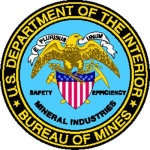- Branche: Mining
- Number of terms: 33118
- Number of blossaries: 0
- Company Profile:
The U.S. Bureau of Mines (USBM) was the primary United States Government agency conducting scientific research and disseminating information on the extraction, processing, use, and conservation of mineral resources.
Founded on May 16, 1910, through the Organic Act (Public Law 179), USBM's missions ...
A circular depression in a karst area. Its drainage is subterranean, its size is measured in meters or tens of meters, and it is commonly funnel shaped.
Industry:Mining
A circular diagram for plotting strikes (with or without dips) of planar features, such as joints, faults, and dikes; so named because clusters of preferred orientations resemble the petals of a rose.
Industry:Mining
A circular drill hole with two opposite vertical grooves that direct the explosive power of the blast.
Industry:Mining
A circular magnetic separator suspended over a conveyor head pulley to extract small pieces of tramp iron.
Industry:Mining
A circular metal disk having diamonds or diamond dust inset in its cutting or peripheral edge. Employed to cut rocks and other brittle substances.
Industry:Mining
A circular movement of water. Eddies may be formed where currents pass obstructions or between two adjacent currents flowing counter to each other.
Industry:Mining
A circular or octagonal shaft furnace, maintaining or increasing its diameter toward the top, and having several tuyeres; used in smelting lead ores.
Industry:Mining
A circular pack consisting of waste stone built within woven fencing fixed to light props. The pack is still effective as support after the props have failed. Wire packs, e.g., are used for small openings in the Rand mines in South Africa.
Industry:Mining
A circular plate conveyor to effect a preliminary grading of coals and removal of stone by hand. A screened-out fraction of the run-of-mine coal is delivered to the table by chute from a conveyor. As the stream of coal revolves on the table, the various grades of coal and the dirt are raked into positions where they are diverted by plows into chutes. The operators are positioned on the inner and outer edges of the table and the coal is not handled but only raked.
Industry:Mining
